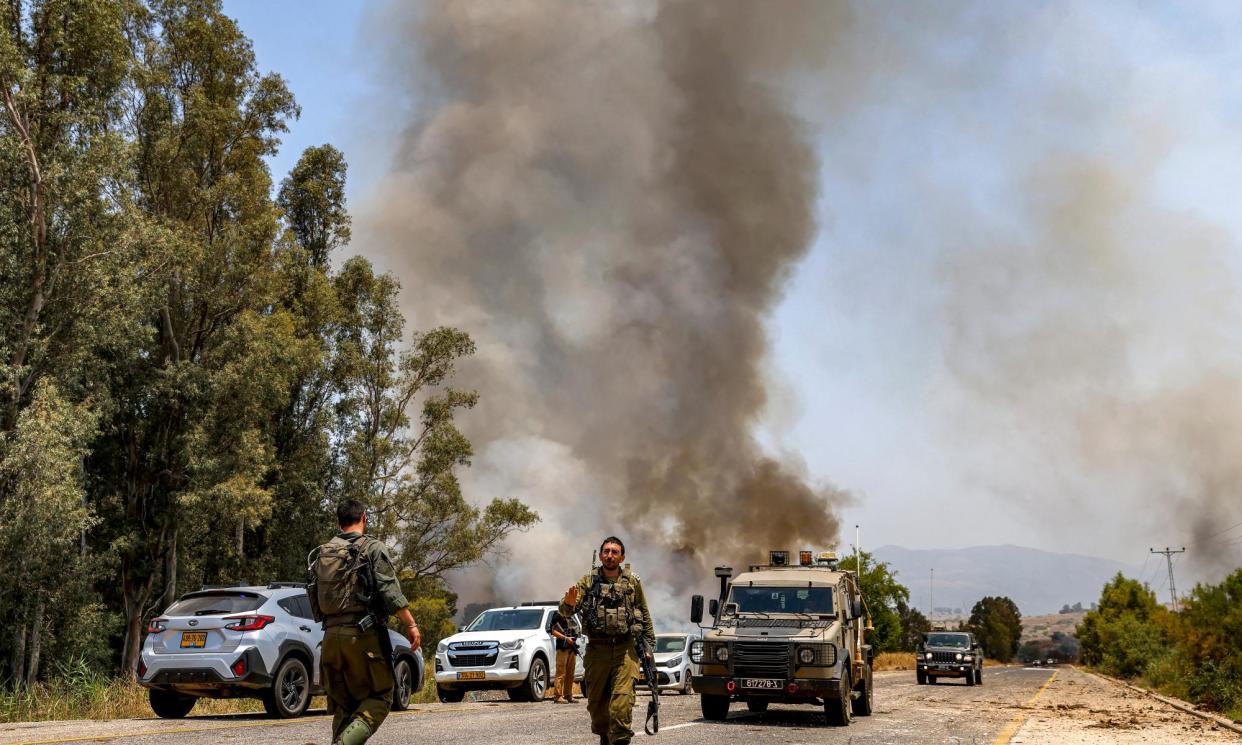Israel’s Iron Dome risks being overwhelmed in all-out war with Hezbollah, says US

Israel’s Iron Dome anti-missile batteries risk being overwhelmed in the opening strikes of any significantly escalated conflict with Hezbollah.
The assessment delivered by US officials late last week, echoing recent analysis by experts in Israel and the United States, comes amid fears that a war with Hezbollah could be a far more dangerous undertaking than the devastating 2006 second Lebanon war, when Israeli bombing caused huge destruction in Lebanon.
The US and France are leading diplomatic efforts to avert a wider conflict between Israel and Hezbollah, amid fears that escalating rhetoric and exchanges of fire across the border could lead to full-scale war.
On Friday, Kuwait’s foreign ministry warned its citizens to avoid travelling to Lebanon and urged those already in the country to leave. There are also reports that officials in the Biden administration told an Israeli delegation in Washington that America would offer security assistance in the event of a wider conflict, while António Guterres, the United Nations secretary general, called for “reason and rationality” to avoid potentially catastrophic consequences for the region and the world.
Since 2006, Hezbollah, the world’s best-armed non-state group, has significantly expanded its arsenal and capabilities, including acquiring suicide drones which Israel has struggled to counter, an anti-aircraft missile capability and a widely expanded array of missiles which experts now believe number between 120,000 and 200,000.
While Hezbollah’s general secretary, Sayyed Hassan Nasrallah, has said his group can count on 100,000 armed men, its core military strength probably amounts to around a third of that, but with a significant number having had combat experience in Syria.
It is the scale of Hezbollah’s missile arsenal, however, and an operational doctrine for their use in a major conflict with Israel, that is likely to be most challenging.
While the majority of Hezbollah’s stockpile comprises tens of thousands of unguided missiles – both short and long range – since 2006 it has acquired hundreds of guided ballistic missiles, with the ability to fire them from hardened bunkers and from mobile launchers.
Complicating the issue has been Hezbollah’s increasing and effective use of drones, including kamikaze weapons, which Israel’s existing air defences have struggled to counter.
A three-year research project by Reichman University’s Institute for Counter-Terrorism in Israel, completed not long before the Hamas attack on 7 October, concluded Hezbollah could fire up to 3,000 missiles a day, a rate that could be sustained for up to three weeks. Its key aim would be to force the collapse of Israel’s air defences.
“The expectation of the public and of a significant portion of the leadership, that the Israeli Air Force and effective Israeli intelligence systems will succeed in preventing most of the rocket attacks on Israel, will be shattered,” the report said. “This is also the case regarding the public’s belief that the threat of Israeli retaliation or a substantial Israeli attack on significant Lebanese assets will force Hezbollah to cease fire or significantly impair their ability to continue attacking Israeli territory.”
According to a recent briefing paper assessing Hezbollah’s rocket capability prepared by the Center for Strategic and International Studies, a US thinktank, “finding and destroying Hezbollah’s rocket and missile capabilities would involve an enormous reconnaissance-strike effort”.
“Hezbollah’s rocket and missile arsenal also includes long-range missiles,” the paper adds. “These are also likely to be used mainly in a coercive capacity, with Hezbollah undertaking long-range strikes against Israeli population centres to undermine Israeli support for the war.”
The most serious challenge, experts believe, is likely to be the sheer number of incoming missiles fired in waves deliberately designed to overwhelm Israel’s air defence systems.
“It would be a tall order for Israeli air defences to confront the widespread rocket arsenal coming from the north,” Seth G Jones, an analyst at the thinktank in Washington, said last week, echoing warnings from Pentagon officials. “We assess that at least some” Iron Dome batteries “will be overwhelmed”, a senior Biden administration official told CNN, which also reported that Israel was moving extra air defence assets to the north.
Israel has about 10 Iron Dome batteries each with about four individual launchers, each battery connected to a radar system that detects incoming missiles. Like all systems, however, it is physically limited by how many threats it can engage simultaneously.
Hezbollah’s upgraded missile capability has triggered warnings about the threat posed to Israel’s civil resilience, prompting plans for coping with mass casualties if war breaks out. Not everyone is convinced that Israel’s military and political leadership has fully grasped the risks.
Speaking at a conference last week Shaul Goldstein, head of Noga, which manages Israel’s electrical systems, warned: “We are not ready for a real war. We live in a fantasy world, in my eyes.” He added that Israel would be “uninhabitable” after 72 hours without power. “You look at all of our infrastructure, the optical fibres, the ports – and I won’t go into the sensitive things – we are not in a good place.” However, he appeared to walk back some comments in a later radio interview after other experts criticised his remarks.
In Gaza City, meanwhile, dozens of Palestinians have been killed in Israeli airstrikes on two densely populated locations. According to initial reports in the Israeli media, the bombings were aimed at assassinating a very senior Hamas commander.
Amid initial reports of tens of casualties, including some still buried under the rubble, the Israel Defense Forces said it had struck Hamas “military infrastructure sites”.
The strikes hit the al-Shati neighbourhood, known as Beach camp, and the al-Tuffah district, which were both struck by significant explosions, killing 38 people, according to Ismail al-Thawabta, director of the Hamas-run government media office. Hamas did not comment on the Israeli claim to have hit its military infrastructure.


